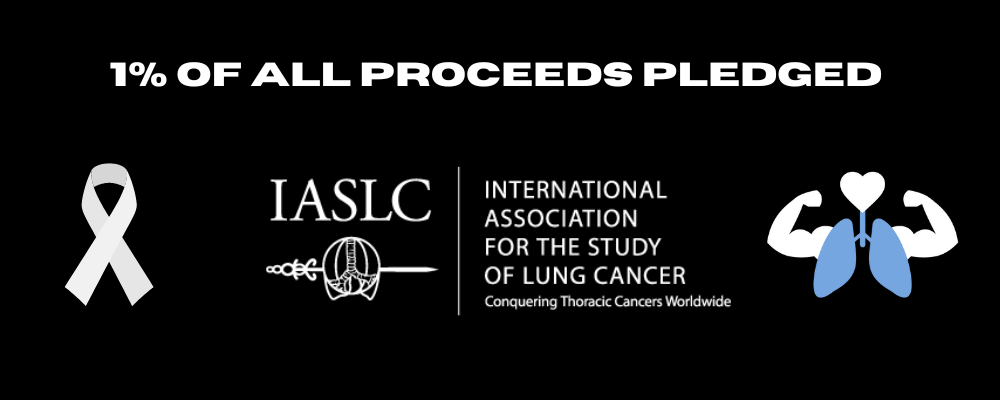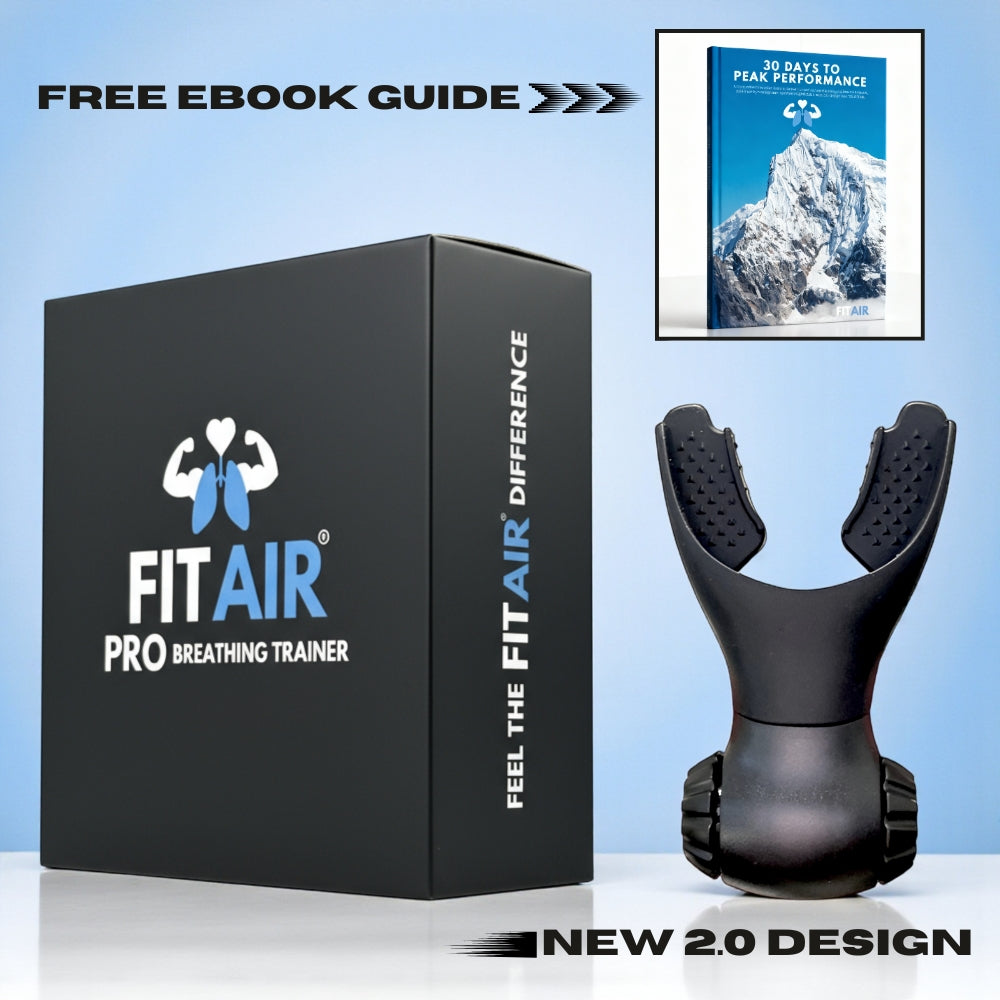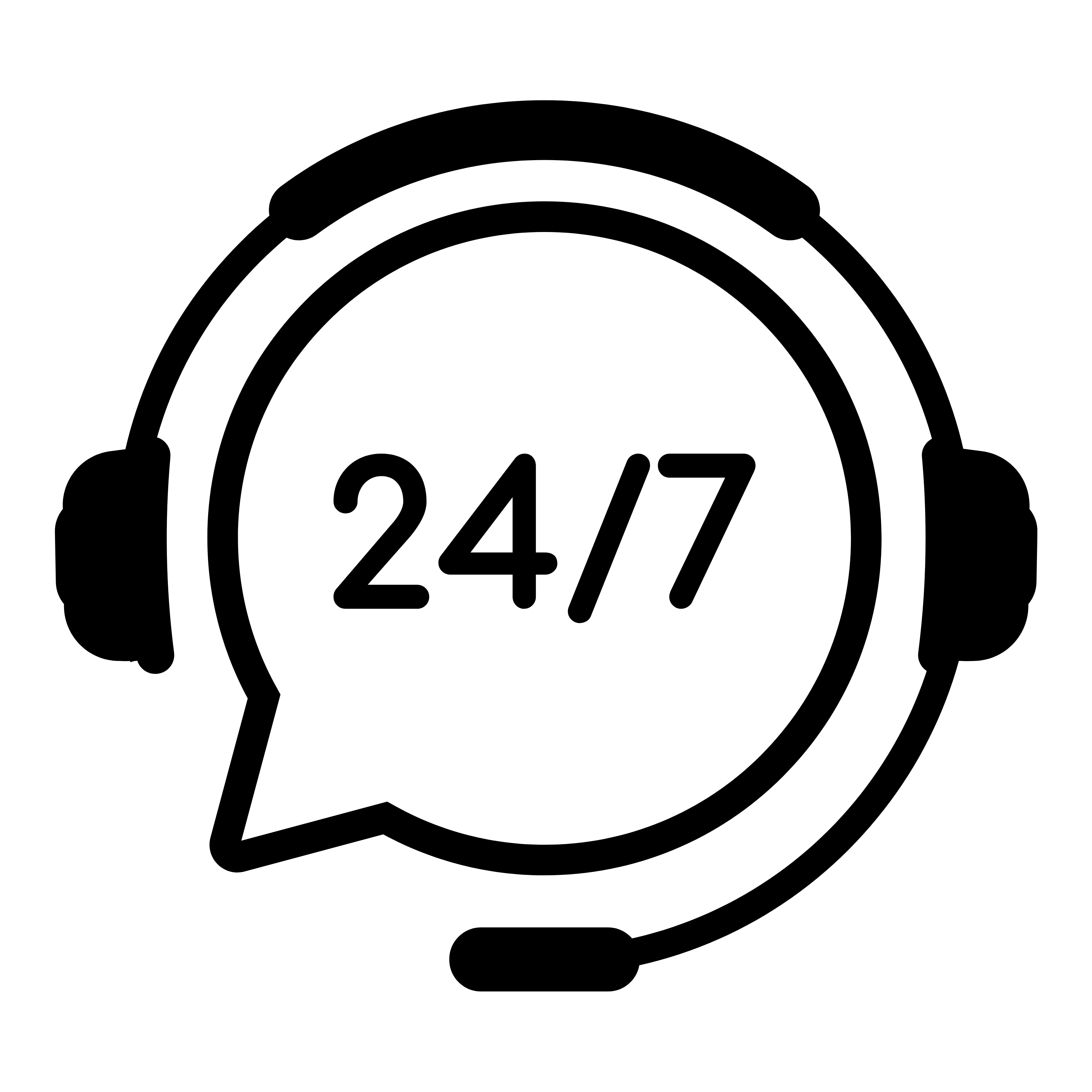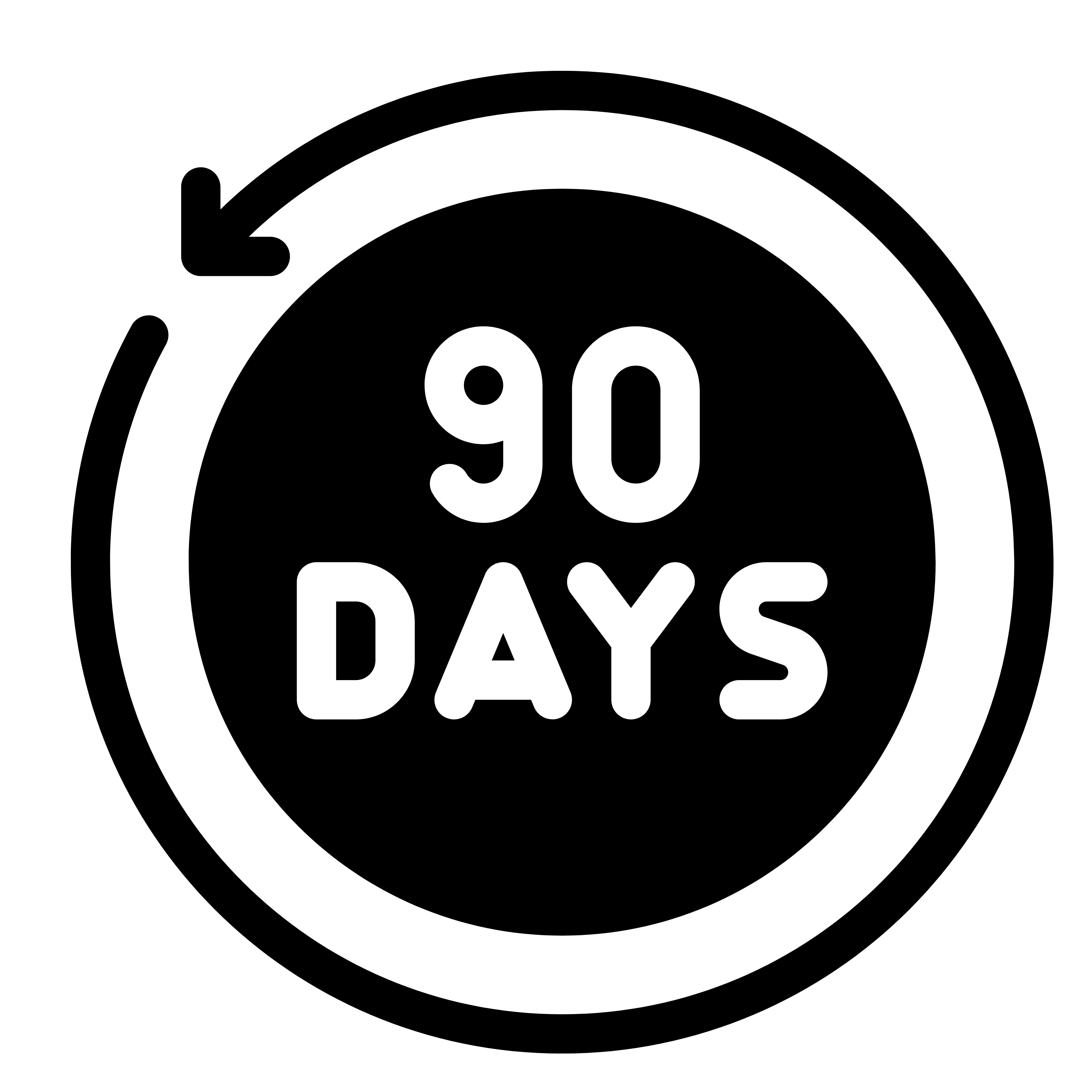⭐⭐⭐⭐⭐ (4.7/5 Stars | 1378 Reviews)
Easily Improve Your Performance & Well-Being by Breath Training With FITAIR PRO 2.0
✅ Can Be Done Anywhere.
✅ 5-10 Minute Sessions.
✅ 4-7 Times a Week.
¡Resultados del entrenamiento de la respiración con FITAIR PRO 2.0 durante sólo 5-10 minutos al día !
⬇️Evidencia científica de respaldo⬇️
Maximize Physical Performance
Maximize Physical Performance
El entrenamiento respiratorio mejora el rendimiento atlético general al mejorar significativamente la resistencia y el aguante, reducir la dificultad para respirar y optimizar la eficiencia respiratoria a través de:
- Fortalecimiento de los músculos respiratorios.
- Mejorando el suministro de oxígeno.
- Reducción de la fatiga respiratoria.
Nota importante: El entrenamiento de la respiración con FITAIR permite al usuario aprovechar los beneficios del entrenamiento de los músculos respiratorios e inspiratorios (RMT/IMT) y la respiración controlada. Nuestro libro electrónico gratuito incluido con cada pedido proporciona una guía paso a paso, rutinas detalladas y las mejores prácticas para ayudarlo a integrar de manera segura y eficaz nuestro exclusivo régimen de entrenamiento de la respiración en su vida.
Evidencia científica de apoyo:
Mejora la fuerza y la resistencia de los músculos respiratorios :
Una revisión sistemática y un metanálisis publicados en el Journal of Sports Sciences confirmaron que el entrenamiento de los músculos respiratorios (RMT) mejora significativamente el rendimiento de resistencia al fortalecer los músculos respiratorios y reducir la fatiga.
Citación:

Illi SK, Held U, Frank I, Spengler CM. Efecto del entrenamiento de los músculos respiratorios en el rendimiento físico en individuos sanos: una revisión sistemática y un metanálisis. Sports Med. 1 de agosto de 2012;42(8):707-24. doi: 10.1007/BF03262290. PMID: 22765281.
Aumenta el suministro de oxígeno :
Una investigación publicada en Frontiers in Physiology demuestra que el entrenamiento de los músculos inspiratorios mejora la eficiencia del oxígeno durante el ejercicio de alta intensidad, mejorando directamente el rendimiento físico y la resistencia.
Citación:

Van Hollebeke M, Poddighe D, Clerckx B, Muller J, Hermans G, Gosselink R, Langer D y Louvaris Z (2022) El entrenamiento de los músculos inspiratorios de alta intensidad mejora los parámetros de oxigenación de los músculos escalenos y esternocleidomastoideos en pacientes con dificultades para destetar: un ensayo controlado aleatorizado. Front. Physiol. 13:786575. doi: 10.3389/fphys.2022.786575
Retrasa la aparición de la fatiga:
Una revisión sistemática publicada en el Journal of Strength and Conditioning Research concluye que el RMT reduce el esfuerzo percibido, la falta de aire y mejora la eficiencia de los músculos respiratorios, lo que permite a los atletas mantener un rendimiento máximo durante períodos más prolongados.
Citación:

Shei RJ. Avances recientes en nuestra comprensión del efecto ergogénico del entrenamiento de los músculos respiratorios en humanos sanos: una revisión sistemática. Journal of Strength and Conditioning Research. 2018 Sep;32(9):2665-2676. DOI: 10.1519/jsc.0000000000002730. PMID: 29985221; PMCID: PMC6105530.
Optimize Recovery & Resilience
Optimize Recovery & Resilience
Important Note: Breath Training is scientifically referred to as Respiratory Muscle Training (RMT).

Below are the findings from a peer-reviewed systematic review and meta-analysis published in the Journal of Strength & Conditioning Research. The paper analyzed 21 randomized controlled trials (426 athletes) to determine whether RMT enhances athletic performance and physiological recovery capacity.
Conclusion Summary: RMT accelerates recovery and increases resilience by improving heart-rate variability, lowering stress, and speeding post-workout recovery.
| Mechanism of Action | Results |
Autonomic Rebalancing (↑ HRV = Heart Rate Variability) |
• HRV ↑ ≈ 15–25 % (root mean square of successive differences = RMSSD, high-frequency HF power)• Resting heart rate ↓ ≈ 4–6 beats/min |
Metabolic Recovery (↓ Blood Lactate) |
• Post-exercise blood lactate ↓ ≈ 1.2–1.8 mmol/L vs control• Lactate clearance time ↓ ≈ 20 % |
Reduced Respiratory Strain & Perceived Fatigue (↓ RPE = Rating of Perceived Exertion) |
• RPE ↓ ≈ 1–2 points (Borg 6–20 scale)• Respiratory rate ↓ ≈ 10–15 % at matched intensity |
Enhanced Inspiratory Strength (↑ MIP) |
MIP ↑ ≈ +20–30 cm H₂O (~25 %)Measured effect size ≈ +0.7 standard deviation |
Respiratory Endurance ↑ (MVV = Maximum Voluntary Ventilation) |
MVV ↑ ≈ 12–16 % (p = 0.002)Respiratory endurance time ↑ ≈ 15–20 % |
Attenuated Respiratory Metaboreflex (↓ Sympathetic Overdrive) |
Improved oxygen saturation & blood flow to locomotor muscles during fatiguing exercise↓ respiratory muscle fatigue by ≈ 17–21 % in swimmers and rowers |
Overall Recovery & Resilience Composite |
HRV ↑ 15–25 %Blood lactate ↓ ~20 %RPE ↓ 1–2 pointsMIP ↑ ~25 %MVV ↑ 12–16 % within 4–6 week s
|
Mechanisms of Action Description
Autonomic Rebalancing (HRV ↑) – Respiratory Muscle Training increases parasympathetic tone (“rest and recover” system), promoting faster recovery and improved stress resilience after exercise.
Metabolic Recovery (Lactate ↓) – Strengthened respiratory muscles enhance oxygen delivery and carbon-dioxide buffering, accelerating lactate clearance and reducing acidosis after exertion.
Reduced Respiratory Strain & Perceived Fatigue (RPE ↓) – Respiratory Muscle Training decreases respiratory effort and sympathetic stress during exercise by reducing the work of breathing and attenuating the respiratory metaboreflex (blood-flow steal to respiratory muscles).
Enhanced Inspiratory Strength (MIP ↑) – Increased maximal inspiratory pressure improves breathing efficiency and reduces respiratory muscle fatigue during effort and recovery.
Respiratory Endurance (MVV ↑) – Improved sustained ventilatory capacity and resistance to respiratory muscle fatigue reduce systemic stress and accelerate post-exercise recovery.
Attenuated Respiratory Metaboreflex (↓ Sympathetic Overdrive) – Delays the reflex vasoconstriction of limb muscles caused by fatigued respiratory muscles, preserving oxygen delivery to working muscles and shortening recovery time.
Overall Recovery & Resilience Composite – Integrated autonomic, metabolic, and respiratory adaptations produce faster systemic recovery, lower stress load, and improved readiness for repeated performance.
Kowalski, Tomasz MSc1; Granda, Dominika PhD2; Klusiewicz, Andrzej PhD3. Practical Application of Respiratory Muscle Training in Endurance Sports. Strength and Conditioning Journal 46(6):p 686-695, December 2024. | DOI: 10.1519/SSC.0000000000000842
Improve Mental Well-Being
Improve Mental Well-Being
El entrenamiento de la respiración es una herramienta transformadora para mejorar el rendimiento mental al:
- Reducir el estrés y la ansiedad
- Mejorando la función cognitiva.
- Facilitando un sueño más reparador
Estos beneficios ayudan a las personas a mantenerse concentradas, serenas y mentalmente resilientes tanto en situaciones de entrenamiento de alta presión como en la vida cotidiana.
Nota importante: El entrenamiento de la respiración con FITAIR permite al usuario aprovechar los beneficios del entrenamiento de los músculos respiratorios e inspiratorios (RMT/IMT) y la respiración controlada. Nuestro libro electrónico gratuito incluido con cada pedido proporciona una guía paso a paso, rutinas detalladas y las mejores prácticas para ayudarlo a integrar de manera segura y eficaz nuestro exclusivo régimen de entrenamiento de la respiración en su vida.
Evidencia científica de apoyo:
Disminuye el estrés/ansiedad:
Un metaanálisis publicado en Scientific Reports reveló que la respiración controlada activa el sistema nervioso parasimpático, reduciendo eficazmente el estrés y la ansiedad al tiempo que favorece la regulación emocional.
Citación:

Fincham, GW, Strauss, C., Montero-Marin, J. et al. Efecto de la respiración artificial sobre el estrés y la salud mental: un metaanálisis de ensayos controlados aleatorios. Sci Rep 13 , 432 (2023). https://doi.org/10.1038/s41598-022-27247-y
Mejora la función cognitiva y la concentración:
La respiración controlada mejora la actividad de las ondas cerebrales alfa, vinculada a un estado de calma y concentración, al tiempo que potencia la memoria y la capacidad de toma de decisiones. Una revisión sistemática publicada en Frontiers in Human Neuroscience destaca cómo el entrenamiento respiratorio mejora la atención y la función ejecutiva, esenciales para un rendimiento mental óptimo.
Citación:

Zaccaro A, Piarulli A, Laurino M, Garbella E, Menicucci D, Neri B, Gemignani A. Cómo el control de la respiración puede cambiar tu vida: una revisión sistemática de los correlatos psicofisiológicos de la respiración lenta. Front Hum Neurosci. 7 de septiembre de 2018; 12:353. doi: 10.3389/fnhum.2018.00353. PMID: 30245619; PMCID: PMC6137615.
Mejora la calidad del sueño
Técnicas como la respiración diafragmática y la respiración lenta favorecen un mejor sueño al reducir la excitación fisiológica y calmar la mente. Un estudio publicado en Fronteras en Psicología Se ha demostrado que la respiración lenta aumenta la actividad parasimpática, lo que conduce a una mejor relajación y un mejor sueño. Estos beneficios sinérgicos tienen un profundo impacto en la claridad mental.
Citación:

Vermeylen S, Honinx E, Broes S, Vandenhoudt H y De Witte NAJ (2022) Evaluación de un marcapasos táctil para problemas de sueño: un estudio piloto de métodos mixtos. Front. Digit. Health 4:908159. doi: 10.3389/fdgth.2022.908159
No se pudo cargar la disponibilidad de retiro
Where is the science?
Where is the science?
***Important note: Breath training is scientifically referred to as Respiratory Muscle Training (RMT). RMT encompasses both Inspiratory & Expiratory Muscle Training (IMT/EMT).***
There are 100s of published clinical & independent research studies documenting the effects of RMT on sports performance & respiratory health.
Below is a credible meta-analysis of 46 different research studies on the effects of RMT on physical performance. The analysis concludes that RMT improves endurance performance.

Next is an article published in the Strength & Conditioning Journal in December of 2024 by Tomasz Kolwalski, a top Physiologist at the National Institute of Sport Research in Warsaw, Poland.
In the article he discusses why RMT is still unknown to many conditioning coaches despite state-of-the-art literature reviews concluding the significant positive effects it has on sports performance. He then goes on to describe the practical applications of RMT for specific sports.



A Note From The FITAIR Team:
At FITAIR we have done our due diligence and put our devices to the test. Not only have we designed what we believe to be the best, most effective, & affordable breathing trainer on the market, but we also have put together a comprehensive eBook guide detailing best practices, methodologies, and regimens for practically every sport or athletic endeavor. It comes free with every order.
We pride ourselves on providing our customers with the tools and knowledge necessary to achieve significant results from breath training in a matter of just 30-days. In fact we guarantee it. If you are not satisfied with our product for any reason whatsoever within 90-days of receiving it, we will give you a full refund, no questions asked.
We are breath training experts. Every person on our team is an athlete who actively uses FITAIR. If you choose to try FITAIR for yourself, you can always reach out and one our team members will happily answer any questions you might have to help you find your own success with breath training.
How does it work?
How does it work?
FITAIR PRO 2.0 is an advanced yet simple breath training device that transforms how you breathe, perform, and recover.
Breath training is scientifically referred to as Respiratory Muscle Training (RMT). RMT is simply strength training for your respiratory muscles, which consists of the diaphragm and intercostal muscles.
Here is how it works:
1. Targeted Overload of the Breathing Muscles
RMT works on the same principle as strength training for any muscle group.
- FITAIR create inspiratory & expiratory resistance (you have to work harder to inhale/exhale).
- This overloads the diaphragm and intercostal muscles, stimulating adaptation and strength gains.
- Over time, these muscles become stronger, thicker, and more fatigue-resistant.
2. Reduced “Oxygen Cost” of Breathing
Once stronger, your breathing muscles require less oxygen to function during exercise.
- Normally, your respiratory system can consume up to 15–20% of total oxygen during intense exercise.
- After RMT, this can drop by up to 30–40%, freeing more oxygen for your limbs and working muscles.
- That’s what leads to measurable improvements in VO₂ max, endurance, and stamina.
3. Delayed Onset of Respiratory Muscle Fatigue
When breathing muscles fatigue, your body activates a metaboreflex — a protective reflex that diverts blood away from your limbs to preserve breathing.
- Stronger respiratory muscles delay this reflex, meaning blood flow stays prioritized for performance.
- The result: less overall fatigue and the ability to maintain intensity longer.
4. Improved Breathing Efficiency & Control
With consistent RMT:
- Each breath moves more air with less effort (greater tidal volume).
- Breathing rate slows and becomes more controlled, improving oxygen exchange efficiency.
- Athletes experience steadier heart rate, lower perceived exertion, and better recovery between intervals.
How do I use it?
How do I use it?
All you need is 5-10 minute sessions, 4-7 days a week breath training with your FITAIR PRO 2.0 device.
*Best practices, detailed routines, and methodologies are outlined in our free eBook.*
Step 1: Insert the mouthpiece into your mouth as you would a mouthguard.
Step 2: Stand or sit comfortably in an upright position maintaining good posture.
Step 3: Twist the resistance adjustment knob at the end of the device to achieve your desired level of breathing resistance.
Step 4: Perform 2 sets of 10 full deep breaths. Work your way up to 2-4 sets of 30 breaths over the course of 2 weeks.
Note: Breath training can be performed simultaneously with various exercises. This is considered an advanced technique and we recommend this to people who are already conditioned athletes. Otherwise, we advise completing the 30-day regimen outlined in our eBook first.
Why choose FITAIR?
Why choose FITAIR?
There is a reason FITAIR is the #1 breathing trainer brand.
At FITAIR we have done our due diligence and put our devices to the test. Not only have we designed what we believe to be the best, most effective, & affordable breathing trainer on the market, but we also have put together a comprehensive eBook guide detailing best practices, methodologies, and regimens for practically every sport or athletic endeavor. It comes free with every order.
We pride ourselves on providing our customers with the tools and knowledge necessary to achieve significant results from breath training in a matter of just 30-days. In fact we guarantee it. If you are not satisfied with our product for any reason whatsoever within 90-days of receiving it, we will give you a full refund, no questions asked.
Shipping & Returns
Shipping & Returns
We offer fast free 2–7 day shipping on all orders.
If you’re not completely satisfied, We've got you covered by our 90-day money-back guarantee.
Contact: Service@fitairpro.com
FITAIR PRO 2.0
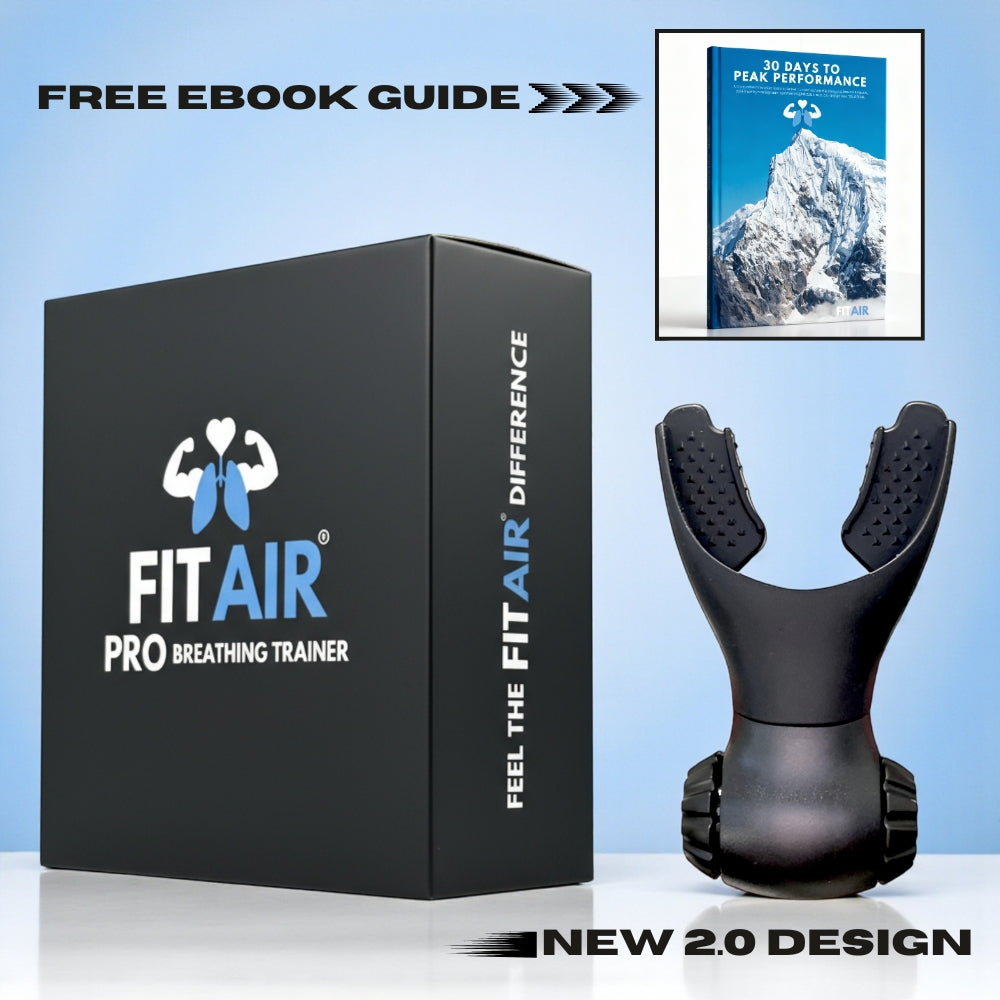
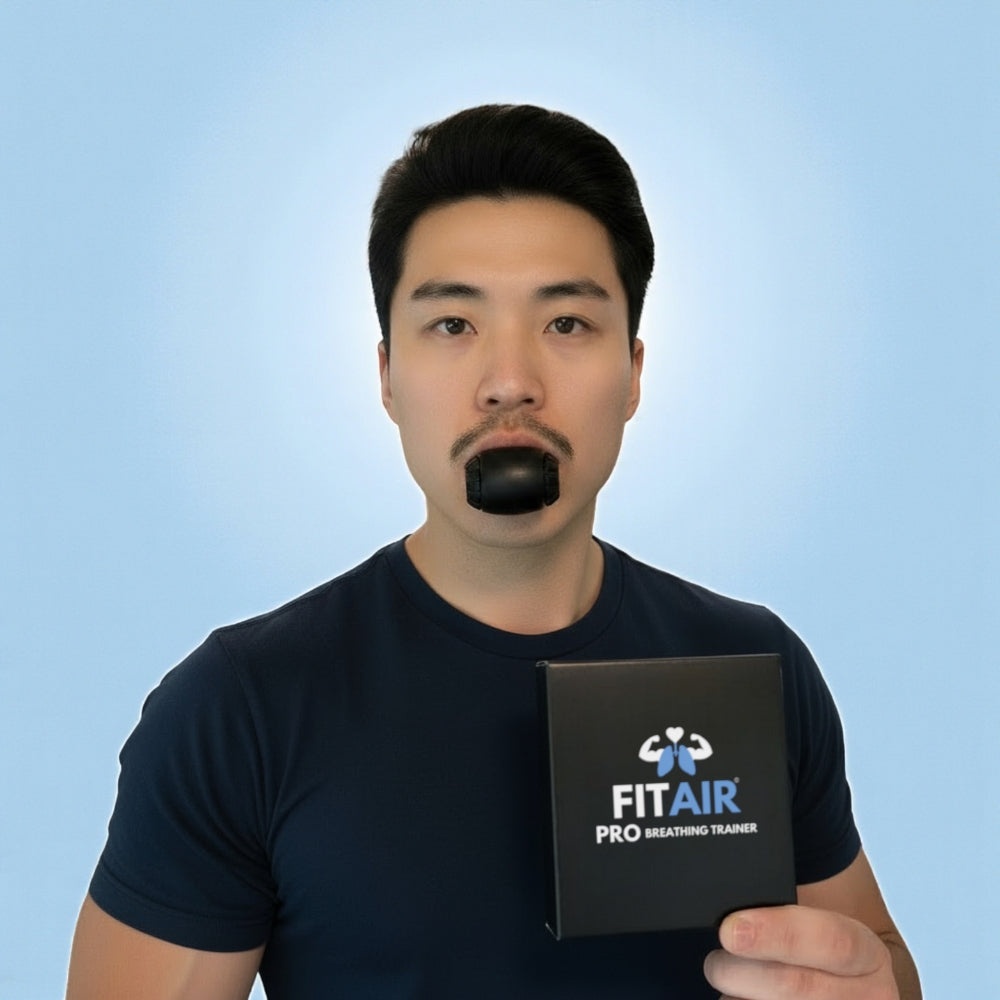
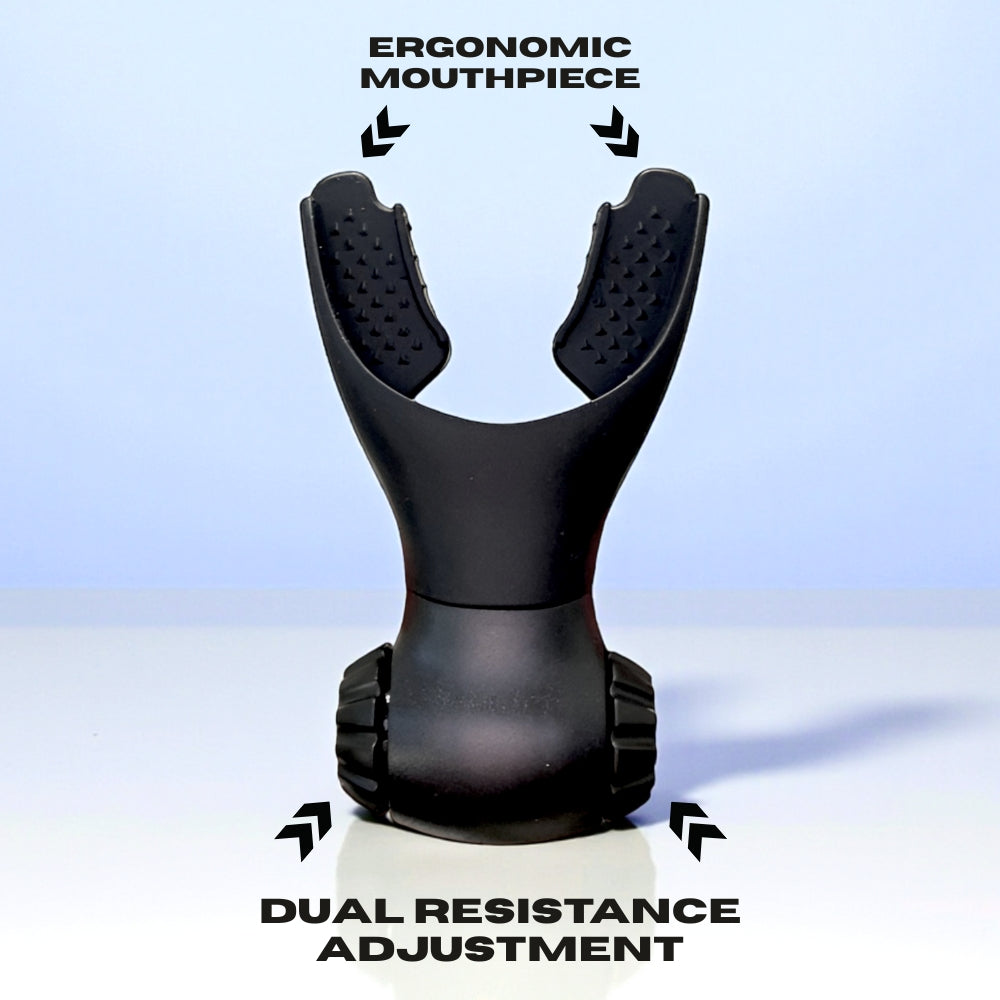

Featured on:





Research + Citations
Backed By Real Published Science.
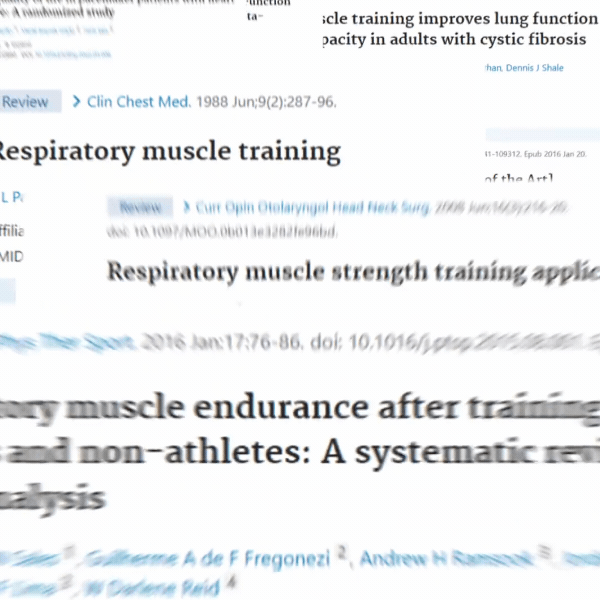
RMT improves endurance and cuts breathlessness
Training your breathing muscles improves endurance performance, boosts breathing muscle strength/endurance, and makes efforts feel easier (less breathlessness), including in tough settings like altitude. This comes up repeatedly in the applied review for coaches and is backed by controlled work it summarizes.
RMT builds stronger breathing muscles that predict higher VO₂ Max
Across competitive athletes, measures of respiratory muscle strength—especially maximal expiratory pressure (MEP)—were significant predictors in models explaining about 51% of the variance in VO₂max/kg. Translation: the stronger your breathing “engine,” the higher your ceiling for aerobic fitness tends to be.
RMT delays a “blood-stealing” reflex from tired breathing muscles (metaboreflex)
When the breathing muscles fatigue, the body can reflexively redirect blood toward them and away from your legs/arms, which hurts performance. RMT seems to toughen those muscles so they fatigue later, blunting this reflex and helping you keep more blood flow for working limbs.
RMT improves performance across many sports — from endurance to combat disciplines
Across multiple studies, respiratory muscle training (RMT) produced measurable improvements in both aerobic and anaerobic sports. Swimmers increased their underwater distance and stroke efficiency after inspiratory training, while cyclists and runners experienced faster recovery and reduced perceived effort during intense exercise. Even athletes in strength and endurance hybrid disciplines like judo and cross-country skiing showed that stronger breathing muscles correlated with higher VO₂ max and greater power output. In simple terms, whether it’s long races or short explosive bouts, stronger lungs consistently translate into better performance.
RMT strengthens the diaphragm and core, improving posture and movement
Slow, controlled breathing through trained muscles doesn’t just affect performance — it also improves recovery and mental calm.
RMT enhances parasympathetic activation (the “rest and recover” system), helping athletes relax faster, sleep better, and manage pre-race stress.
RMT strengthens the diaphragm and core, improving posture and movement
Respiratory Muscle Training (RMT) improves how efficiently you breathe when oxygen demand is high — like during intense workouts, sprints, or training at altitude. Research shows that athletes with stronger respiratory muscles use less oxygen for the same effort, meaning their bodies stay calmer and more efficient under stress. This training delays the point where you start gasping for air, maintains steadier oxygen delivery to your working muscles, and keeps fatigue at bay for longer. In short, RMT helps you stay in control of your breathing — and your performance — even when the pressure peaks.
Excellent 4.6 | 60,000+ Customers
Stronger Lungs & Endurance in Just Minutes a Day with FITAIR
Boost Endurance & Stamina: Train the breathing muscles that power your performance and recovery.
Feel the Difference Fast. Notice stronger breathing after just a few short sessions—no gym or equipment needed.
Maximize Oxygen Efficiency: Improve airflow control for longer, stronger workouts.
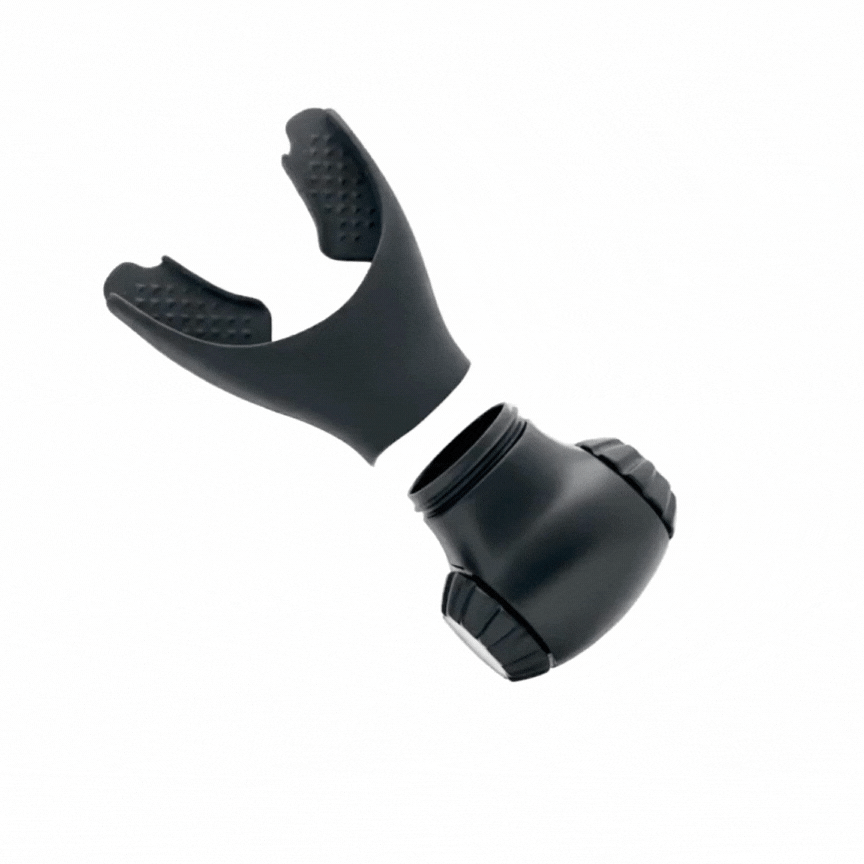
PUSH PAST YOUR LIMITS.
Finally push past that wall that’s been holding you back. FITAIR helps you train the muscles behind every breath—so you can perform stronger, recover faster, and breathe easier in every workout.
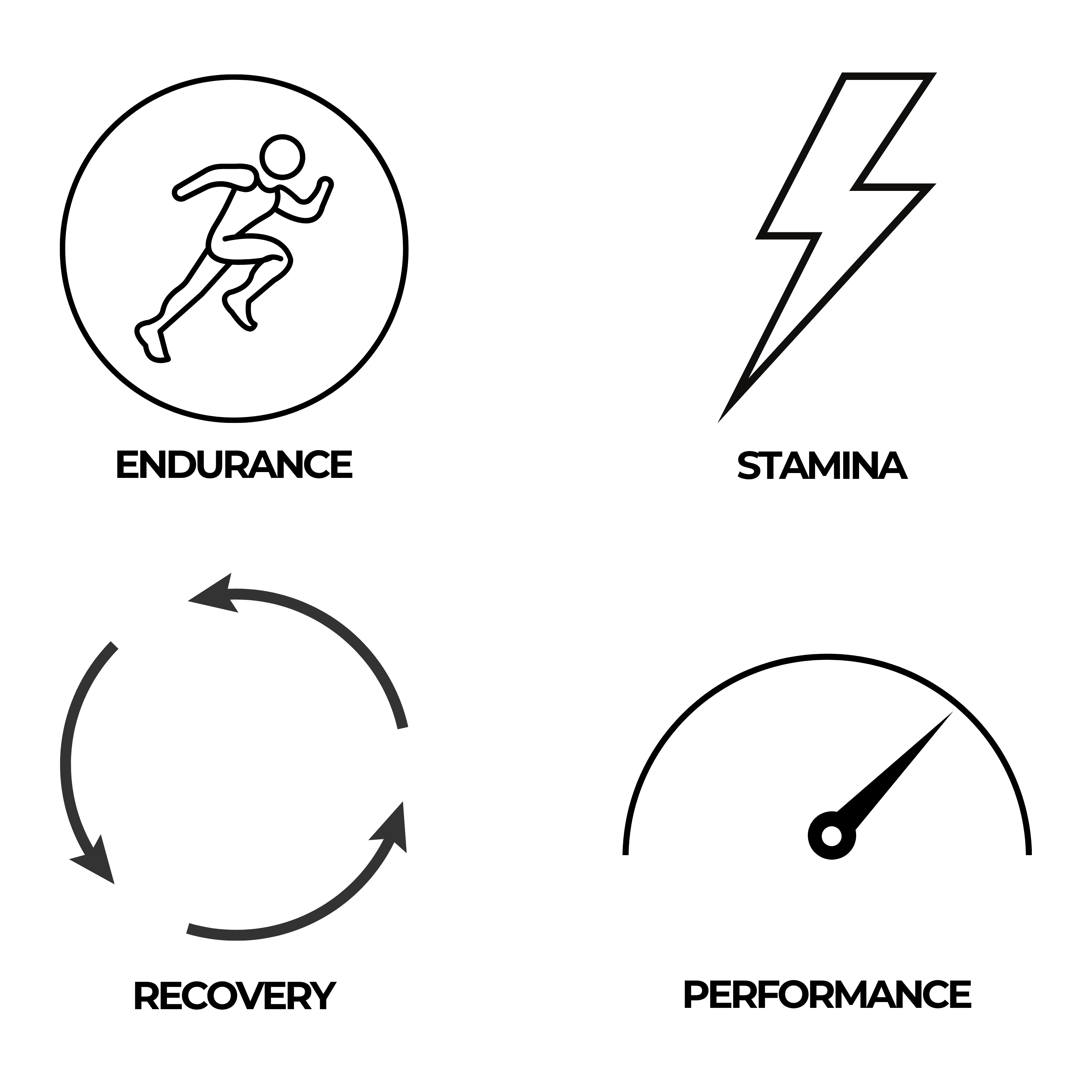
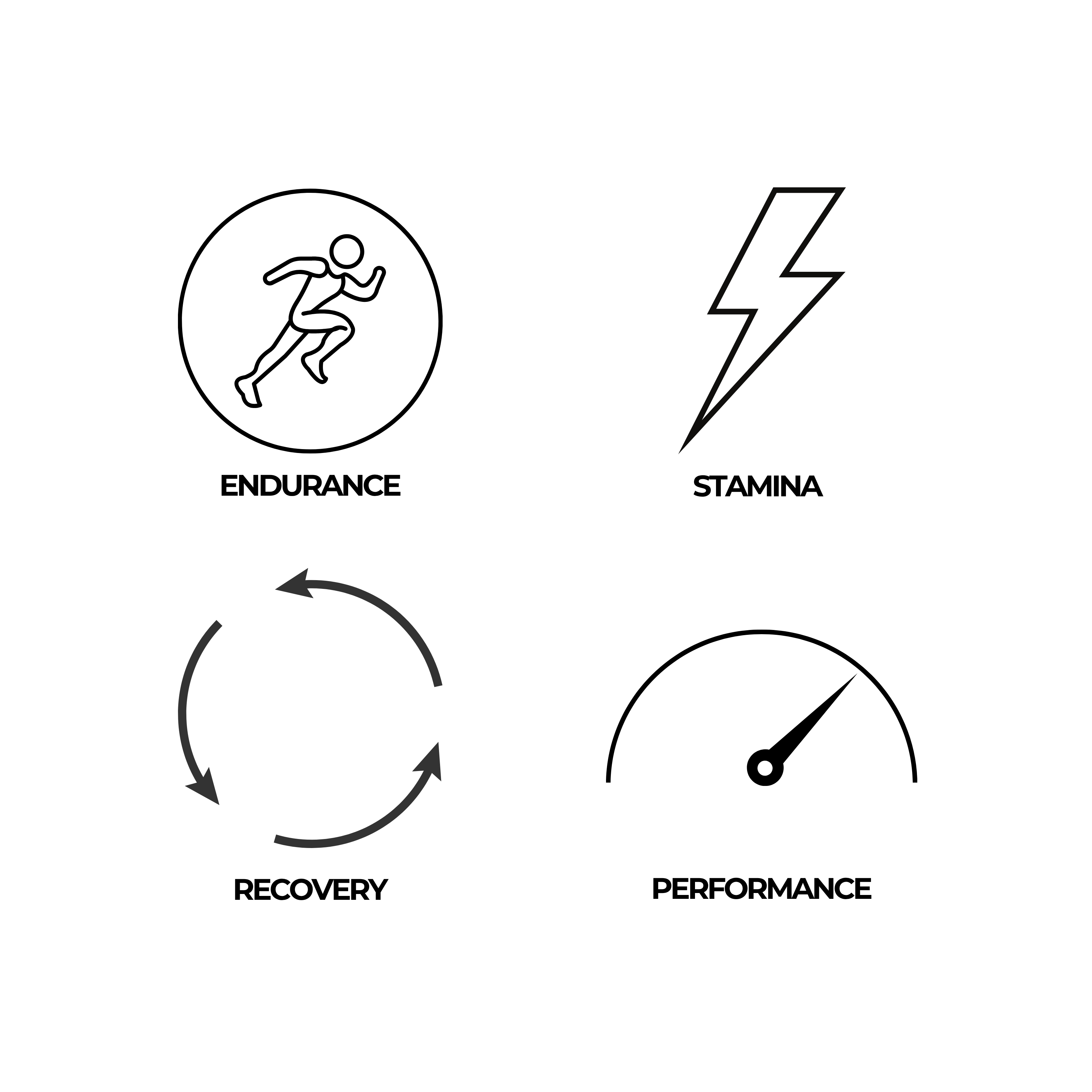
TRAIN THE SAME.
PERFORM BETTER.
Both groups trained identically — but only one added FITAIR PRO. By strengthening the respiratory muscles, Athlete A extended endurance by up to 35%, proving that smarter breathing leads to stronger performance.
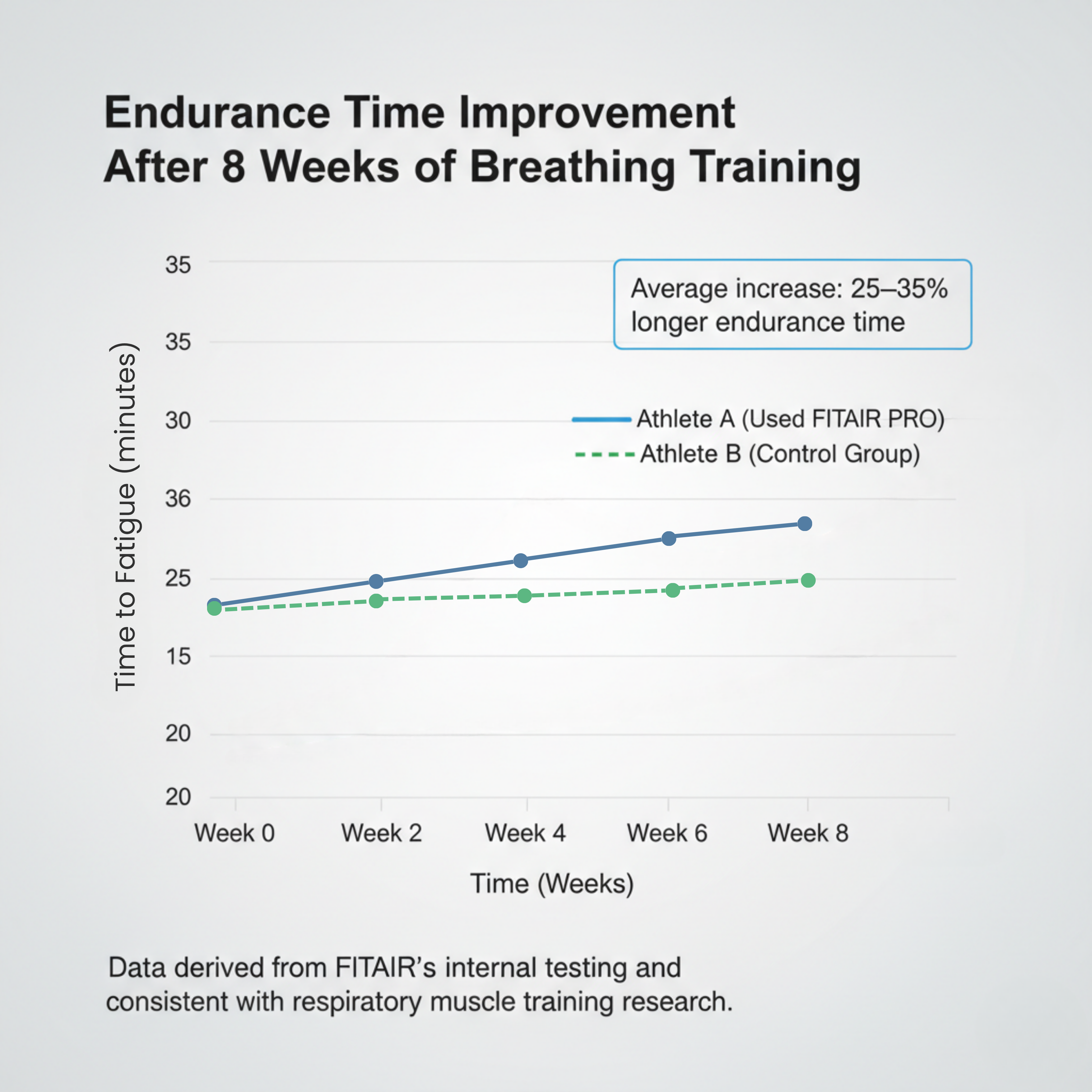
PRECISION DESIGN.
POWERFUL RESULTS.
Crafted for comfort and stability, allowing a natural, secure fit during every breath session—no slipping or irritation.
Smoothly controls resistance to ensure consistent air pressure and balanced muscle engagement with every inhale.
Progressively increase difficulty as your lungs grow stronger—just twist and train at your own pace.
Designed for confident handling, even during intense training or sweaty sessions.
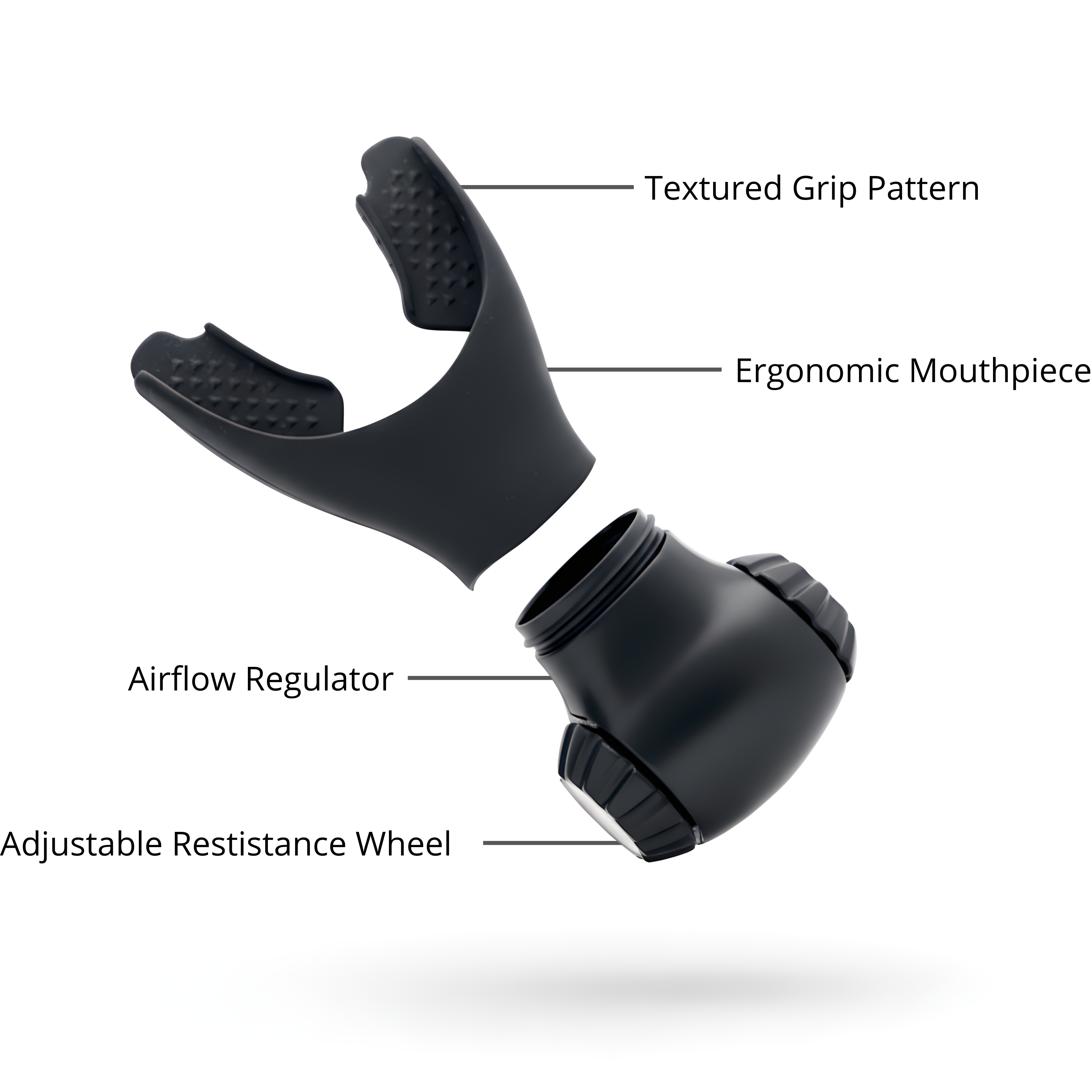
User reported results after 30 days of breath training with The FITAIR PRO.
98%
Increased Stamina & Endurance.
91%
Decreased Fatigue & Shortness of Breath.
88%
Better Sleep Quality.
90%
Decreased stress and anxiety.
96%
Reduction of Asthma & COPD Symptoms. (Those who suffer from)
Based on a random customer survey 30 days post purchase with 2000+ participants.
60,000+
FITAIR Users.
(Featuring The Original FITAIR PRO Model)
FAQs
What is breath training & how does it work?
(Please read the scientific evidence outlined in the drop downs above.)
The FITAIR PRO 2.0 strength trains the respiratory muscles via breath resistance. A process scientifically referred to as Respiratory Muscle Training (RMT).
In addition to RMT, The FITAIR PRO 2.0 also doubles as a breathwork practice due to the controlled breathing exercises. We refer to the combination of both as breath training.
Stronger respiratory muscles provide several benefits, including improved breathing efficiency, reduced breathlessness, and enhanced oxygen delivery to the body's tissues. This leads to better overall physical performance and endurance, especially in athletes.
For individuals with respiratory conditions such as COPD or asthma, stronger respiratory muscles can significantly alleviate symptoms, making daily activities easier and improving quality of life. Additionally, enhanced respiratory muscle strength can aid in quicker recovery from respiratory illnesses and help maintain lung function as we age.
Respiratory muscles are typically only strengthened through intense prolonged cardiovascular exercise. Therefore, strength training your respiratory muscles allows you to quickly and easily improve your physical fitness and overall well being.
Furthermore, it is possible to achiever a higher degree of respiratory muscle strength with RMT than with just cardiovascular exercise alone because of the added resistance. It is the same principle as strength training your skeletal muscles with added weight vs only body weight. For example, you will not be able to achieve the same degree of strength with bodyweight squats as you can with weighted squats. This is why even the most conditioned endurance athletes can benefit from breath training.
How do I use it?
All you need is 5-10 minutes a day breath training with your FITAIR PRO 2.0 device.
*Best practices, detailed routines, and methodologies are outlined in our free eBook.*
Step 1: Insert the mouthpiece into your mouth as you would a mouthguard.
Step 2: Stand or sit comfortably in an upright position maintaining good posture.
Step 3: Twist the resistance adjustment knob at the end of the device to achieve your desired level of breathing resistance.
Step 4: Perform 2 sets of 10 full deep breaths. Work your way up to 2-4 sets of 30 breaths over the course of 2 weeks.
Note: Breath training can be performed simultaneously with various exercises. This is considered an advanced technique and we recommend this to people who are already conditioned athletes. Otherwise, we advise completing the 30-day regimen outlined in our eBook first.
How often should I use FITAIR?
Just 5–10 minutes session, 4-7 times a week is enough to build real results. FITAIR is designed to fit into any routine — use it during warm-ups, post-workout recovery, or even on rest days.
Is it difficult to use?
Not at all. Simply adjust the resistance wheel to your comfort level, breathe through the mouthpiece, and feel your lungs work harder with each controlled inhale and exhale.
Is this right for me?
The FITAIR PRO 2.0 is a safe effective option for people of all fitness levels to improve respiratory health, athletic performance, and overall wellbeing.
The lungs are one of the most vital organs of our bodies. Training the muscles that support them should not be overlooked.
Whether you are an athlete looking to gain an edge, a sufferer of lung ailments, or simply someone who wants to feel their best. The FITAIR PRO 2.0 is right for you.
Is this safe for beginners?
Absolutely. FITAIR lets you start at light resistance and gradually increase as your breathing muscles strengthen. It’s completely safe, non-invasive, and recommended by coaches and physiologists for controlled respiratory training.
Is FITAIR only for athletes?
Not at all. While athletes love it for endurance and recovery, everyday users benefit just as much. Whether you’re a runner, lifter, cyclist, or just want to breathe deeper and feel more energetic — FITAIR adapts to your level.
Can it help with running, cycling, or combat sports?
Definitely. FITAIR helps athletes in all endurance and high-intensity sports build stronger breathing capacity. You’ll feel more control on climbs, during sprints, or in the final rounds of a match — when every breath counts.
Can it help with stress or anxiety?
Yes. Strengthening your breathing muscles and practicing controlled breathwork helps calm your nervous system. Many users find that it improves focus, relaxation, and sleep quality over time.
How long does it take to see results?
FITAIR PRO 2.0 users have reported noticing improvements in as little as 3 days. The more you train the better results you will have. Just like weight lifting and cardiovascular exercise, improvements from breath training will compound over time, and slowly diminish after cessation. Gains can be sustained by breath training only 3 times a week. FITAIR PRO 2.0 is designed to last a lifetime. A small one time investment for forever benefits.
What results can I expect?
With regular use, you’ll experience:
- Improved stamina and endurance
- Faster recovery between workouts
- Better focus and control under pressure
- Reduced shortness of breath and fatigue
What if it doesn't work for me?
We promise you will see improvements! Just like any form of exercise, if you stick with it, you will see improvements. However, in the unlikely event that you do not see experience improvements, we offer a 90-Day money back guarantee. Please reach out to our customer service and one of our team members will assist you with a refund no questions asked. Service@FITAIRPRO.com
Can breathing actually improve performance?
Yes — research in journals like the Journal of Applied Physiology and British Journal of Sports Medicine confirms that respiratory muscle training improves oxygen efficiency, delays fatigue, and enhances endurance. Stronger breathing muscles mean more energy and control under pressure.
Is there real science behind this?
Yes. Over 30 years of research has shown that respiratory muscle training increases endurance, improves recovery, and reduces perceived effort during exercise. FITAIR applies the same proven principle in a simple, reliable form.
What makes FITAIR different from other breathing devices?
Unlike bulky tech-based trainers or restrictive masks, FITAIR uses pure mechanical resistance — no batteries, no glitches, and no false “altitude” gimmicks. It’s simple, durable, and scientifically proven to build real lung strength safely.
What if it doesn’t work for me?
We stand behind our product with a 90-day money-back guarantee. If you don’t feel noticeable improvement in your breathing or performance, you’ll get a full refund — no questions asked.
Does it replace regular cardio training?
No — FITAIR complements your workouts. Think of it as resistance training for your lungs. It makes your cardio more effective by improving how your body uses oxygen, so you perform better in every session.
How do I clean it?
It’s easy. Simply rinse the mouthpiece with warm water and mild soap, then let it air dry. FITAIR is built from high-grade silicone and ABS materials for hygiene and durability.
ENDLESS RESEARCH BACKED BENEFITS
Better Sleep Quality
Reduces Fatigue
Strengthens & Tones Core
Decreases Stress & Anxiety
Improves Asthma Symptoms
Boosts Stamina & Endurance
Better Overall Respiratory Health
Improves COPD Symptoms
Reduces Congestion
Improves Recovery
Tones Facial Muscles
Improves Shortness of Breath
Better Sleep Quality
Reduces Fatigue
Strengthens & Tones Core
Decreases Stress & Anxiety
Improves Asthma Symptoms
Boosts Stamina & Endurance
Better Overall Respiratory Health
Improves COPD Symptoms
Reduces Congestion
Improves Recovery
Tones Facial Muscles
Improves Shortness of Breath
90-Day money back Guarantee.
If you are not satisfied with the results within 90-days, please reach out and one of our team members will happily assist you with a refund.
Email: Service@FITAIRPRO.com
|
Others | |
|---|---|---|
Lifetime Warranty |
||
Custom Design |
||
Free eBook |
||
Affordable |
||
Backed by Real Science |
||
Used by Coaches & Athletes |
||
90-Day Money-Back Guarantee |
